#Flutter app development framework
Explore tagged Tumblr posts
Text
#Flutter Architectural Layers#Flutter app structure#Flutter app development framework#Best flutter app development framework#Structure of the Flutter app development#Rendering in Flutter app#top flutter app development company
0 notes
Text
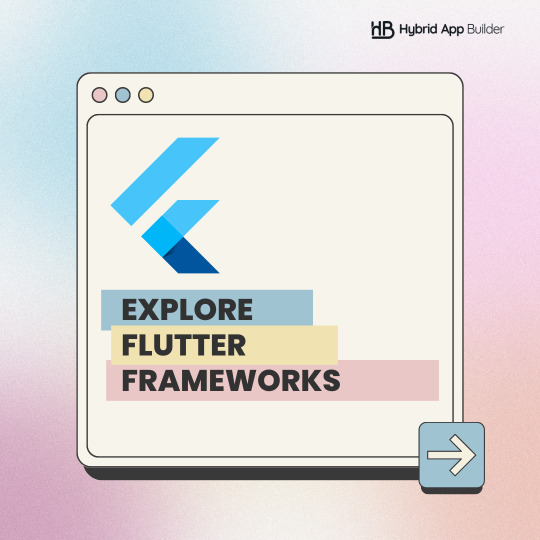






🚀 Ready to take your Flutter development to the next level?
🔥 Check out our top picks for Flutter frameworks and take your app to new heights! 📱
3 notes
·
View notes
Text
Best Cross-Platform App Development Frameworks

In today’s fast-paced digital world, businesses need to reach users on multiple platforms without excessive development costs. Cross-platform app development has emerged as the perfect solution, allowing developers to write a single codebase and deploy it across iOS, Android, and even web applications.
But with so many frameworks available, how do you choose the right one?
In this guide, we’ll explore the best cross-platform app development frameworks of 2025, their benefits, key features, and how they compare in terms of performance, scalability, and cost-effectiveness. Whether you’re a startup looking for a quick MVP or an enterprise aiming for a seamless multi-platform experience, this guide will help you make an informed decision.
What is a Cross-Platform App Development Framework?
A Cross-Platform App Development Framework is a software tool that enables developers to create mobile applications that run on multiple operating systems (iOS, Android, Windows) using a single codebase. Unlike native development, which requires separate coding for different platforms, cross-platform frameworks streamline the process, reducing development time and costs.
What Are the Benefits of Cross-Platform App Development Frameworks?
1. Code Reusability: Write Once, Run Anywhere
One of the most significant advantages of cross-platform development is code reusability. Instead of writing separate codebases for iOS and Android, developers can create a single codebase that works across multiple platforms. This approach:
Reduces development time by eliminating redundant coding efforts.
Simplifies debugging and maintenance, as there is only one codebase to manage.
Ensures consistency in application logic and functionality across all platforms.
Boosts efficiency, allowing developers to focus on innovation rather than rewriting code.
2. Cost-Effective: Reduce Development and Maintenance Costs
Developing separate native apps for Android and iOS requires two development teams, doubling costs. With cross-platform frameworks:
Businesses save money by hiring a single development team instead of two.
Maintenance costs are lower since updates and bug fixes are applied universally to all platforms.
Faster development cycles lead to quicker product launches, reducing time-to-market expenses.
Startups and SMEs benefit from budget-friendly app development without compromising performance.
3. Faster Development: Quick Deployment Across Multiple Platforms
Time-to-market is crucial in today’s competitive landscape. Cross-platform frameworks enable rapid development by:
Using pre-built components and libraries, which speed up the development process.
Allowing simultaneous deployment on different platforms reduces the time required to launch an app.
Supporting features like Hot Reload (Flutter) and Live Reload (React Native), which enable instant updates and real-time testing.
Enhancing developer productivity, leading to shorter development cycles and faster iterations.
4. Uniform User Experience: Maintain UI/UX Consistency
Cross-platform development ensures a seamless and consistent user experience across all devices. This is crucial for brand recognition and customer satisfaction. Benefits include:
Consistent UI elements, ensuring a uniform look and feel across all platforms.
Frameworks like Flutter and React Native provide platform-specific UI components, making apps feel native.
Improved user engagement and retention due to a familiar and intuitive interface.
Eliminates the risk of disjointed user experiences caused by inconsistent design on different operating systems.
5. Wider Market Reach: Launch Apps on Different OS Simultaneously
Cross-platform development allows businesses to reach a larger audience by launching applications on multiple operating systems at once. This results in:
Increased customer base, as apps are available to both iOS and Android users simultaneously.
Higher revenue potential, as businesses don’t miss out on either market segment.
Scalability, enabling future expansion to platforms like Windows, macOS, and Web with minimal effort.
A competitive edge, as businesses can launch faster than those relying on traditional native app development.
What Are the Best Frameworks for Developing Cross-Platform Mobile Apps?
1. Flutter
Developer: Google
Language: Dart
Why Choose Flutter?
Flutter, developed by Google, is one of the most popular cross-platform app development frameworks. It is known for its fast development, high-performance rendering, and visually appealing UI components. Flutter allows developers to build natively compiled applications for mobile, web, and desktop using a single codebase.
Hot Reload: One of Flutter’s standout features is Hot Reload, which enables developers to see code changes instantly without restarting the application. This accelerates the development process and enhances productivity.
Rich UI Components: Flutter offers a comprehensive widget-based architecture, allowing developers to create visually rich and customizable UI components that provide a native-like experience.
High Performance: The framework uses Skia, a powerful 2D rendering engine, to deliver smooth animations and seamless performance.
Strong Community Support: Being backed by Google, Flutter has extensive documentation, active developer communities, and continuous updates that keep it evolving.
Use Cases:
Flutter is widely used for:
MVP (Minimum Viable Product) Development: Ideal for startups looking to validate their ideas quickly.
eCommerce Apps: Provides a smooth and responsive user experience for online shopping platforms.
On-Demand Service Apps: Used for apps like ride-hailing, food delivery, and home services due to its fast rendering and interactive UI.
Popular Apps Built with Flutter:
Google Ads — A mobile version of Google’s advertising platform.
BMW App — The automobile giant’s mobile application for seamless customer engagement.
Alibaba — A widely used eCommerce app leveraging Flutter for a dynamic user experience.
2. React Native
Developer: Meta (formerly Facebook)
Language: JavaScript
Why Choose React Native?
React Native is an open-source JavaScript framework developed by Meta (formerly Facebook). It is one of the most widely used cross-platform frameworks, known for its efficiency, reusability, and fast development cycle.
Reusable Components: Developers can write once and reuse components across both Android and iOS platforms, reducing development time and cost.
Live Reload: Similar to Flutter’s Hot Reload, React Native offers Live Reload, which enables developers to see the impact of their code changes instantly.
Strong Community Support: With Meta’s backing, React Native enjoys an active open-source community, providing extensive libraries, third-party plugins, and developer support.
Third-Party Plugin Support: The framework supports third-party modules, enhancing functionality and speeding up development.
Use Cases:
React Native is widely used for:
Social Media Apps: It powers apps like Facebook and Instagram due to its high performance and native-like UI.
Streaming Apps: Popular for building media and video streaming platforms like Netflix and YouTube.
FinTech Solutions: Provides security and seamless functionality for banking and financial applications.
Popular Apps Built with React Native:
Facebook — The company’s own app is built on React Native.
Instagram — A leading photo and video-sharing platform.
Airbnb — A global marketplace for travel and accommodation services.
3. Xamarin
Developer: Microsoft
Language: C#
Why Choose Xamarin?
Xamarin, developed by Microsoft, is a robust framework that allows developers to build native-like applications using C# and .NET. It is well-suited for enterprise applications that require seamless API integration and high performance.
Seamless API Integration: Xamarin provides direct access to native APIs, ensuring apps feel truly native while being built with a shared codebase.
Strong Microsoft Ecosystem: Developers can leverage Azure, Visual Studio, and .NET libraries to enhance functionality and performance.
Code Sharing: Up to 90% of the codebase can be shared across different platforms, significantly reducing development time.
Use Cases:
Xamarin is commonly used for:
Enterprise Applications: Many large organizations use Xamarin to create secure and scalable business applications.
Healthcare Apps: With a focus on performance and security, Xamarin is a preferred choice for healthcare and medical applications.
Financial Software: Due to its robust security features, Xamarin is used for banking and financial applications.
Popular Apps Built with Xamarin:
Microsoft Outlook — A widely used email and productivity application.
Alaska Airlines — A seamless flight booking and travel app.
The World Bank — A high-performance mobile solution for the financial sector.
4. Kotlin Multiplatform
Developer: JetBrains
Language: Kotlin
Why Choose Kotlin Multiplatform?
Kotlin Multiplatform, developed by JetBrains, is an emerging cross-platform framework that enables developers to use Kotlin’s native features while sharing code between Android, iOS, and web applications.
Native Performance: Unlike other frameworks that rely on JavaScript, Kotlin Multiplatform compiles native code, delivering high performance.
Flexible Architecture: Developers can write shared business logic while keeping platform-specific implementations for UI and other critical functions.
Officially Supported by Google: Since Google supports Kotlin for Android development, Kotlin Multiplatform is future-proof and integrates well with existing Android applications.
Use Cases:
Kotlin Multiplatform is best suited for:
Business Applications: Ideal for corporate and enterprise solutions that require multi-platform compatibility.
Data-Driven Apps: Used in applications that rely on analytics and big data.
Utility Apps: Well-suited for tools like task managers, note-taking apps, and scheduling apps.
Popular Apps Built with Kotlin Multiplatform:
Cash App — A widely used mobile payment service.
PlanGrid — A construction productivity tool for professionals.
5. Unity
Developer: Unity Technologies
Language: C#
Why Choose Unity?
Unity is a powerful cross-platform game development framework that allows developers to create immersive gaming experiences with high-quality graphics and real-time rendering.
Best for Game Development: Unity is the leading framework for 2D and 3D game development, offering advanced physics engines and rendering capabilities.
AR/VR Support: It integrates with ARKit (Apple) and ARCore (Google), making it the top choice for augmented and virtual reality applications.
Cross-Platform Compatibility: Unity supports mobile, PC, web, and even console gaming, providing extensive platform coverage.
Use Cases:
Unity is widely used for:
Gaming Apps: The go-to framework for both indie and AAA game developers.
AR/VR Applications: Used in training simulations, interactive marketing, and immersive experiences.
3D Simulations: Deployed in architecture, automotive, and industrial applications.
Popular Apps Built with Unity:
Pokémon GO — The globally popular AR-based game.
Angry Birds 2 — A sequel to the hit mobile game.
Call of Duty Mobile — A high-performance shooter game.
6. Ionic
Developer: Ionic Framework Team
Language: HTML, CSS, JavaScript (with Angular, React, or Vue)
Why Choose Ionic?
Ionic is a popular open-source framework for building cross-platform apps with a web-first approach. It leverages standard web technologies while providing a native-like experience.
UI Components Library: Comes with pre-built UI components that offer a native feel on both iOS and Android.
Supports Multiple JavaScript Frameworks: Works seamlessly with Angular, React, and Vue.
Capacitor for Native Access: Provides direct access to native APIs, making hybrid apps more powerful.
Use Cases:
Ionic is widely used for:
Progressive Web Apps (PWAs): Ideal for web apps that function like mobile applications.
Business and Enterprise Apps: Used for internal tools and customer-facing applications.
E-Learning Applications: Popular in education technology due to its modularity.
Popular Apps Built with Ionic:
MarketWatch — A financial news and stock market tracking app.
Sworkit — A home workout and fitness app.
Sanvello — A mental health and wellness application.
How to Choose the Right Cross-Platform App Development Framework?
Selecting the right framework depends on various factors. Consider the following before making your decision:
1. Project Requirements
Different frameworks cater to different types of applications. If your app requires complex UI, high performance, or custom native integrations, opt for Flutter or Kotlin Multiplatform. For business apps requiring a stable ecosystem, Xamarin is a solid choice.
2. Development Language
Your team’s expertise in a particular programming language influences framework selection:
If you prefer Dart, go with Flutter.
For JavaScript developers, React Native is the best option.
C# developers should choose Xamarin.
If your team is experienced in Kotlin, Kotlin Multiplatform is ideal.
3. Performance Needs
For applications requiring smooth animations, complex UI interactions, and high-performance graphics, Flutter or Kotlin Multiplatform is the best choice. Unity is preferred for gaming and AR/VR apps due to its advanced rendering engine.
4. Community & Support
A strong developer community ensures better documentation, frequent updates, and troubleshooting support. React Native and Flutter have the largest communities, making them excellent choices for long-term scalability.
5. Cost Efficiency
Choosing the right framework also impacts development and maintenance costs. React Native and Flutter are widely used, meaning a larger talent pool and lower hiring costs. Xamarin, being a Microsoft product, is more cost-effective for enterprises already using the Microsoft ecosystem.
Why Choose CodeRower for Cross-Platform App Development?
At CodeRower, we specialize in delivering top-tier cross-platform mobile applications tailored to your business needs. Our expert developers leverage cutting-edge technologies to create seamless, high-performance apps that run smoothly across multiple platforms. Here’s why businesses trust us:
Expert Developers: Our team is proficient in leading cross-platform frameworks, including Flutter, React Native, and Xamarin.
Faster Time-to-Market: We use pre-built components, efficient coding practices, and agile methodologies to accelerate app development.
Cost-Effective Solutions: With a single codebase, we reduce development and maintenance costs without compromising quality.
Seamless UI/UX Design: We ensure consistent branding, intuitive interfaces, and engaging user experiences across all devices.
Scalability & Performance: Our applications are built to handle growing user bases with robust architecture and optimized performance.
Whether you need an MVP for your startup or an enterprise-grade solution, CodeRower provides end-to-end cross-platform app development services that drive business success.
Conclusion
Cross-platform app development has revolutionized the way businesses create mobile applications. Whether you prioritize UI, performance, or cost-effectiveness, choosing the right framework can significantly impact your app’s success.
CodeRower is a leading software development company specializing in cross-platform app development that helps businesses build high-performance applications for iOS, Android, and web using a single codebase. Our expert developers leverage Flutter, React Native, Xamarin, and Kotlin Multiplatform to create scalable, cost-effective, and feature-rich applications tailored to your business needs.
With a proven track record in delivering enterprise-grade applications, MVPs, and industry-specific solutions, CodeRower ensures seamless user experiences, optimized performance, and faster time-to-market.
If you’re looking for expert cross-platform app development services, CodeRower is here to help! Contact us today and bring your mobile app ideas to life.
Frequently Asked Questions
1. What is the difference between native and cross-platform app development?
Native app development involves building separate applications for each platform (iOS, Android) using platform-specific languages like Swift (iOS) and Kotlin (Android). Cross-platform app development, on the other hand, allows developers to write a single codebase that runs on multiple platforms, reducing development time and costs.
2. How does CodeRower help in cross-platform app development?
CodeRower specializes in developing high-quality, scalable cross-platform applications tailored to business needs. Our team of experts leverages cutting-edge technologies like Flutter, React Native, and Xamarin to deliver seamless, cost-effective solutions.
3. What are the key benefits of cross-platform app development?
Cross-platform app development offers several advantages, including:
Faster Development — A single codebase reduces development time.
Cost Efficiency — Saves resources compared to building separate native apps.
Wider Market Reach — Apps run on both iOS and Android simultaneously.
Easier Maintenance — Updates and bug fixes apply across platforms.
Consistent UI/UX — Ensures a uniform experience across devices.
4. What are some of the best cross-platform development frameworks?
Popular frameworks for cross-platform development include:
Flutter — Developed by Google, ideal for high-performance, visually rich apps.
React Native — Backed by Meta (Facebook), suitable for dynamic, fast apps.
Xamarin — A Microsoft-backed framework using C# and .NET.
Kotlin Multiplatform — Allows code sharing across iOS and Android.
5. How does CodeRower ensure a high-quality cross-platform app?
At CodeRower, we follow industry best practices to ensure top-notch app quality:
Agile Development — Rapid iterations for faster delivery.
Rigorous Testing — Performance, security, and usability testing.
Optimized Codebase — High performance with minimal latency.
User-Centric Design — Smooth navigation and engaging UI/UX.
Post-Launch Support — Regular updates and maintenance.
6. Why should I choose CodeRower for my cross-platform app development?
At CodeRower, we provide:
Expertise in multiple frameworks — Flutter, React Native, Xamarin, and Kotlin Multiplatform.
Custom-tailored solutions — Designed to fit your business requirements.
Scalability and performance — Apps optimized for speed, security, and efficiency.
Cost-effective development — Faster time-to-market without compromising quality.
Dedicated support — End-to-end maintenance and updates to keep your app running smoothly.
Ready to build your cross-platform app? 🚀 Contact CodeRower today to discuss your project requirements and take your business to the next level!
#development tools#framework#software development framework#agile framework#cross platform#flutter developers#flutter development#reactnative#reactjs developers#software development#app development#web app development#android app development#web development#ios app development#custom app development#game development#custom software development
0 notes
Text

Discover why Flutter is the go-to framework for cross-platform app development. With features like hot reload, a single codebase, and rich widgets, it enhances efficiency and UI consistency across iOS, Android, and web apps. While it has a learning curve and ecosystem limitations, its benefits make it a powerful choice for developers.
For "Flutter App Development"
0 notes
Text
Flutter vs. React Native: Best Framework for Your Cross-Platform App

Choosing the right framework is critical to the success of your app. In the world of cross-platform development, React Native and Flutter stand out as the go-to choices for building apps efficiently for Android and iOS from a single codebase. Both frameworks offer unique advantages, but which one is best suited for your project? Let’s dive in to help you decide.
Understanding React Native
React Native, created by Facebook in 2015, enables developers to create mobile applications using JavaScript. By extending the popular React framework for web development to mobile platforms, React Native simplifies development without sacrificing a native-like user experience.
Key Features of React Native:
Reusable Codebase: Write once, run on both Android and iOS with minimal adjustments.
Native Rendering: Uses native UI components, ensuring apps look and feel like true native apps.
JavaScript Expertise: Leverages an already widely used programming language, reducing the learning curve for teams.
Ideal Use Cases:
React Native excels in developing apps that prioritize functionality, such as:
Social Media Apps: Facebook and Instagram are prime examples.
E-commerce Apps: Platforms focusing on core features and fast iteration.
MVPs for Startups: Quick time-to-market with robust functionality.
When it comes to custom mobile app development, React Native provides a practical solution for businesses aiming to deliver apps across multiple platforms while optimizing time and costs.
Flutter: Google’s Vision for Cross-Platform Apps
Launched in 2017, Flutter is Google's open-source framework for creating visually stunning and highly performant apps. Powered by Dart, Flutter is designed for developers who value consistent design and seamless performance across platforms, including mobile, web, and desktop.
Key Features of Flutter:
Rich Widgets Library: A customizable set of widgets allows precise control over UI design.
Hot Reload: Real-time changes boost productivity during development.
Platform Independence: Build apps that scale beyond mobile to web and desktop platforms.
Ideal Use Cases:
Flutter shines in applications requiring advanced graphics and consistency, such as:
Graphically Intense Apps: Complex animations and interactive designs.
Multi-Platform Apps: Apps needing a unified experience across devices.
Startups with Design-First Focus: Beautiful, responsive apps built efficiently.
For developers focused on web app development, Flutter's multi-platform capabilities make it an excellent choice for creating seamless digital experiences across devices.
What Are the Key Differences Between Flutter and React Native?
When deciding between Flutter and React Native, it's essential to understand their key differences to choose the right framework for your project.
1. Programming Language
React Native uses JavaScript, making it a natural choice for teams with web development experience.
Flutter uses Dart, which offers robust features but has a smaller developer community.
2. UI/UX Customization
React Native relies on native components, providing a consistent platform look but less flexibility for custom UI designs.
Flutter uses its widget-based system, enabling highly customizable and visually consistent designs.
3. Performance
React Native uses a JavaScript bridge, which may impact performance in graphics-heavy apps.
Flutter compiles directly to native code, ensuring better performance for complex animations and high-performance apps.
4. Multi-Platform Support
React Native focuses on mobile, with third-party tools enabling web functionality.
Flutter natively supports mobile, web, and desktop, making it a more versatile choice.
Advantages and Disadvantages of React Native and Flutter
When choosing between React Native and Flutter, understanding their pros and cons can help streamline your decision for mobile app development.
React Native: Pros and Cons
Advantages
Large Community Support: Built on JavaScript, React Native benefits from a vast developer community and numerous libraries.
Faster Development: If you’re familiar with JavaScript and React, React Native allows faster transitions into mobile app development.
Cost Savings: A single codebase works for both iOS and Android, reducing resources.
Disadvantages
Performance Issues: May struggle with complex animations or graphics due to the JavaScript bridge.
Limited Customization: Relies on native components, limiting UI design options.
Dependency on Third-Party Libraries: Advanced features depend on third-party tools, which can cause delays.
Flutter: Pros and Cons
Advantages
Superior Performance: Compiles directly to native code, improving speed, especially for animations.
Highly Customizable UI: Uses widgets for advanced and flexible UI design.
Single Codebase Across Platforms: Works for mobile, web, and desktop development.
Disadvantages
Larger File Size: Flutter apps consume large amount of storage
Limited Dart Expertise: Dart is less common than JavaScript, making skilled developers harder to find.
Still Maturing for Web Support: Flutter’s web capabilities are still evolving, with some performance and compatibility challenges.
Future of Cross-Platform Development
The demand for cross-platform frameworks continues to grow, driven by the need to build apps efficiently for multiple platforms. React Native and Flutter are both evolving rapidly, supported by major tech companies like Facebook and Google. While React Native leads in market share, Flutter’s rich UI capabilities and growing popularity make it a serious contender.
React Native or Flutter : Which one to pick
The choice between Flutter and React Native depends on your project goals, team expertise, and app requirements. Both frameworks are powerful tools that cater to different needs, ensuring you can deliver an excellent user experience.
#web development#app developing company#web app development#Flutter vs. React Native#best app development framework
0 notes
Text
#Flutter apps in India#Flutter framework#hire flutter developers in India#dedicated Flutter developers
1 note
·
View note
Text
Real-Time Tracking Solutions for Smarter Logistics Management

In the hectic contemporary logistics, the need for efficiency and transparency has never been greater. Businesses are continually seeking ways to function more efficiently, save costs, and increase customer satisfaction by means of effectiveness. Now add real-time tracking solutions in corporate logistics management, this trend has transformed the area.
Artificial intelligence (AI) and the Internet of Things (IoT) provide formerly unheard-of access and control over the full supply chain. Therefore, in this article, you’ll learn everything about real-time tracking in modern logistics.
What are real-time tracking solutions in logistics?
Real-time tracking systems are technologies enabling businesses in the context of logistics to continuously monitor the movement and condition of products all along the supply chain. These systems provide consistent, current data on cargo location, condition, and projected arrival timings by combining GPS tracking, IoT sensors, artificial intelligence algorithms, and cloud-based platforms.
Whether they track a fleet of cars, monitor warehouse inventory, or assure cold chain integrity, real-time tracking solutions in logistics provide managers with the information they need to make quick decisions. This level of visibility is very essential in the internationally connected economy of today as errors or delays might have significant financial effects.
Benefits of real-time tracking systems

Applied in logistics, real-time tracking solutions offer several advantages allowing more intelligent logistics management:
1. Better visibility and openness
Real-time monitoring provides unrivaled visibility into the complete logistics supply chain. This transparency allows logistics managers to identify assets, track shipments, and precisely regulate inventories. Knowing exactly where items are at any one moment enables businesses to ensure timely delivery, reduce the risk of lost or stolen products, and alert customers.
2. Improved Efficiency and Productivity
Real-time tracking systems provide meaningful data and automate tedious tasks, therefore simplifying logistical procedures. Artificial intelligence (AI) based fleet management solutions, for instance, may maximize delivery routes, therefore reducing fuel consumption and trip times. By enabling real-time stock level monitoring made possible by warehouse tracking systems, one reduces the likelihood of stockouts or overstocking and aids to automatically restocking.
3. Financial Cutbacks
By simplifying processes, reducing idle time, and avoiding inventory losses, real-time tracking solutions may significantly minimize operational expenses. One can help to further lower costs by replacing expensive on-site infrastructure with cloud-based logistics solutions in Australia. Real-time data lets businesses also quickly identify inefficiencies and implement remedies, therefore lowering long-term expenses.
4. Enhanced Contentment of Customers
Online shoppers of today need fast, consistent delivery. Real-time order monitoring and correct shipment estimates enable businesses to meet these goals. Usually improving the customer experience, this degree of transparency helps to develop trust.
Key components of real-time monitoring
Analyzing the key components of real-time tracking solutions will enable one to fully understand their impacts:
1. GPS tracking
GPS tracking in logistics is the foundation for all sorts of real-time monitoring devices. It gives accurate current position of the assets, cargoes, and vehicles as desired by our client. Fleet management solutions with GPS tracking units installed are employed widely in order to control vehicle actions, circulation, and confirmation of delivery punctuality.
2. IoT in Chain Management
Real-time tracking mainly relies on the Internet of Things (IoT) app development that links digital environments to real objects. Sensors for IoT, which gather location, temperature, humidity, and any other related information, are mounted on goods, cars, and machines. After that, this data is transferred to cloud-based logistic systems for analysis and application direction of influence, directing direct decisions.
3. AI Solution for Lite Supervision
Using data and a highly significant number of prediction figures, AI solutions for real-time tracking can possibly augment tangible real-time monitoring systems. AI development in Australia can bring out patterns, estimate probable time lags, and suggest appropriate inventory or the path of action.
4. Cloud logistics platform
More central on cloud-based logistics platforms are real-time tracking systems. These systems collect data from various origins such as smart devices, geographic position systems, as well as artificial intelligence arrangements, then display in a clear manner. Real-time information from any place is invaluable to logistics managers when they make decisions.
5. Mobile App Development
Indeed, given the fact that real-time tracking solutions give urgent access to the necessary logistical information, the last ordinarily rely on mobile application development in Australia. Most logistic managers may track shipments, communicate with drivers, and manage stock through their tablets or smartphones using mobile apps.
Applications in contemporary logistics for real-time tracking
As used in a variety of subfields of the logistics sector, real-time monitoring presents different difficulties and expectations based on its application.
1. Fleet management
One of the most common applications of real-time tracking solutions is the use of fleet management solutions. Organizations monitor vehicle movements, optimize paths, and reduce fuel consumption through GPS logistics tracking systems. In addition, increasing asset durability and reducing the time the vehicle is out of use is the ability of real-time data to suggest preventive measures.
2. Warehouse Inventory Management
Real-time tracking systems undoubtedly depict what constitutes good warehouse inventory management. These systems are designed to replace replenishment, order status, and detect the motion of warehoused products. AI-based warehouse management solutions also prevent the likelihood of stock out or having excess inventory through demand forecasting and inventory levels.
3. Cold Chain Logistics monitoring
Real-time monitoring systems are effective in cold chain logistics, where products must be kept within specific temperatures. IoT sensors provide live updates on temperature, humidity, and other factors to ensure the best quality of food, drugs, and other fragile goods.
4. Supply Chain Management
These technologies start from the producer level and extend to the end-user, providing end-to-end information that helps businesses organize the monitoring of their goods. This awareness often enables businesses to identify gaps in the supply chain, allowing them to recognize issues like inventory positioning and bottlenecks.
Real-time tracking in logistics – the future
The development and future of logistics technology will be mainly governed by the perpetual advancement of real-time tracking technology. With the evolution of AI, IoT, and cloud computing technologies, and experiences, we expect to see more enhanced real-time tracking in logistics having higher accuracy, predictive ability, and automation in the forthcoming tracking system generations.
App integration services by SSTech Logistics Solutions manage the bulk product, type of vehicle used, online booking tracking system, and estimated time and cost of delivery to meet the increasing demand for efficient supply chain logistics.
IoT in supply chain management will continue to advance as more items and resources connected to the network generate more data and higher-quality information.
Conclusion
Today’s smart logistics management involves the use of real-time tracking systems as these offer the best supply chain management solutions. The logistics industry in Australia will be compelled to become customer-oriented, less costly, and adjust to accommodate new technologies embraced by companies that use them. Applying all of them at present means they can expand within the extremely competitive global environment.
#sstechsystem#sstech system#webdevelopment#appsdevelopment#appdevelopment#india#business#australia#b2b#AI Development#AI#ai framework#flutter#chatgpt#logistics industry in Australia#smart logistics management#SSTech Logistics Solutions#IoT#Supply Chain Management#Real-time tracking in logistics#Real-time tracking#Cold Chain Logistics#Warehouse Inventory Management#Mobile App Development#Fleet management#GPS logistics tracking#AI Solution#warehouse tracking systems
1 note
·
View note
Text
Why Ionic Outperforms Flutter in 2024: 7 Data-Driven Reasons to Choose Ionic

In the competitive realm of hybrid app development, selecting the right framework is crucial for ensuring the success of your project. As of 2024, Flutter and Ionic are the two leading contenders in the field. While both frameworks have their strengths, an in-depth analysis of data and technical aspects reveals that Ionic may have the edge for many developers and businesses. Here’s why Ionic stands out, supported by compelling statistics and technical insights.
1. Hybrid Approach Enhances Performance
Performance is a pivotal factor in choosing a development framework. Ionic’s hybrid approach utilizes pre-existing plugins and technologies that enhance development efficiency while maintaining high performance. Ionic delivers a consistent 60 FPS across both desktop and mobile platforms, demonstrating its ability to offer smooth and reliable user experiences.
Flutter, known for its native compilation and custom rendering engine, also achieves 60 FPS. However, while Flutter’s hot reload feature can accelerate development, it doesn’t always translate to faster overall development time. Data suggests that Flutter's hot reload can reduce development time by up to 63%, but this benefit is often counterbalanced by the complexity of the app being developed.
2. Superior UI Customization and Flexibility
UI design flexibility is another critical factor where Ionic excels. Ionic leverages web technologies such as HTML, CSS, and JavaScript, providing developers with a comprehensive library of pre-designed components. This allows for highly customizable and responsive UIs, with standard-based web components that can be styled to resemble native elements, ensuring a consistent look and feel across various platforms.
Flutter, in contrast, employs its own rendering engine and offers a range of pre-designed widgets. While these widgets adhere to Material Design and Human Interface guidelines and provide extensive customization options, they may not offer the same level of flexibility as the standard web components used by Ionic. For businesses seeking a tailored UI with rapid implementation, Ionic’s approach offers a significant advantage.
3. Enhanced Code Portability and Maintenance
Code portability is a crucial aspect of modern app development, and Ionic’s use of web technologies facilitates this with ease. Developers can deploy a single codebase across mobile, desktop, and Progressive Web Apps (PWA), simplifying code maintenance and updates. This approach reduces the time and effort required to manage different platform versions.
Flutter also supports cross-platform code sharing but relies on Dart, which is less widely adopted than JavaScript. Although Flutter's single codebase approach is effective, developers may face a steeper learning curve with Dart, potentially impacting the speed of development and onboarding.
4. Developer-Friendly Ecosystem
The developer experience is greatly influenced by the ecosystem surrounding a framework. Ionic’s ecosystem is designed to enhance developer convenience, offering extensive documentation and compatibility with popular JavaScript frameworks such as AngularJs , React, and Vue. This integration allows developers to leverage their existing skills and tools, facilitating faster development and maintenance.
Flutter requires proficiency in Dart, a less common language compared to JavaScript. Although Flutter provides comprehensive documentation, the learning curve associated with Dart can be a barrier for new developers or those transitioning from other languages. Ionic’s ecosystem, with its focus on familiar technologies, presents a more accessible option for many developers.
5. Accelerated Development and Deployment
Speed is critical in the app development lifecycle. Ionic’s hybrid approach and efficient use of web technologies contribute to quicker development cycles. With its vast library of components and plugins, developers can rapidly assemble and deploy applications, minimizing the need for extensive custom coding.
Flutter’s hot reload feature is designed to speed up development by allowing real-time updates without restarting the app. While this feature is beneficial, the overall speed of development can still be affected by the complexity of the application and the need for frequent updates. Ionic’s streamlined approach often results in faster development and deployment times.
6. Cost-Effective Development
Cost considerations are always at the forefront of app development decisions. Ionic’s utilization of web technologies and pre-existing plugins often results in more cost-effective development compared to Flutter. The use of JavaScript and established web frameworks typically leads to lower development costs, as teams can build on their existing knowledge and tools.
In contrast, Flutter’s development costs may be higher due to the need for specialized Dart expertise and potentially longer development times for complex applications. Although Flutter can deliver high-performance apps, the associated costs can be a significant factor for businesses operating within tight budgets.
7. Established Community and Support
Community support and available resources play a crucial role in the development process. Ionic’s longer presence in the market has fostered a robust ecosystem of resources, tutorials, and community support. This established network provides valuable assistance for troubleshooting, learning, and keeping up with the latest advancements.
While Flutter is supported by a rapidly growing community and benefits from Google’s backing, it is relatively newer compared to Ionic. As a result, the community support and resources for Flutter are still expanding. For developers seeking a well-established support network, Ionic’s longstanding presence offers a substantial advantage.
Ionic’s Technical Superiority
Ionic excels not only in performance and development efficiency but also through its robust technical features:
Plugin Integration: Ionic utilizes Cordova and, more recently, Capacitor plugins to access host operating system features such as Camera, GPS, and Flashlight. This integration allows developers to build applications that leverage native device functionalities while using a unified codebase.
Comprehensive Framework: Ionic supports building apps that can be customized for a range of platforms, including Android, iOS, Windows, Desktop (with Electron), and modern browsers. This versatility is facilitated through Ionic’s build tools and simplified command-line interface (CLI), which streamlines the app-building and deployment process.
Extensive UI Components: Ionic includes a wide array of mobile components, typography, interactive paradigms, and an extensible base theme. Web Components used in Ionic provide custom elements and methods for interaction. Notable components like virtual scroll allow for smooth scrolling through extensive lists, while tabs create native-style navigation with history state management.
Development Tools: Ionic offers services that enable code deploys and automated builds. Although its own IDE, Ionic Studio, was discontinued in 2020, the CLI remains a powerful tool for project creation, plugin management, push notifications, and native binary generation.
Conclusion
In conclusion, while both Flutter and Ionic offer distinct benefits for hybrid app development, data and technical insights indicate that Ionic may be the preferable choice for many projects. With its hybrid approach, superior UI customization, code portability, and developer-friendly ecosystem, Ionic presents a compelling option for businesses looking to develop high-performance, cost-effective applications.
If you're considering developing a new application or updating an existing one, hiring Ionic developers could significantly enhance your project’s success. Ionic’s strengths in development efficiency and technical versatility make it a robust and effective choice in the competitive landscape of hybrid app development.
By choosing Ionic, and with the expertise of skilled Ionic developers, you can harness a framework with a proven track record, ensuring efficient development and deployment processes. For a well-established support network and a streamlined development experience, Ionic is the framework to consider.
#Flutter#Ionic#Mobile App Development#Cross Platform Apps#App Development#Hybrid Apps#IonicFramework#Flutter VS IONIC#Tech Comparison#App Performance#Dart Programming#JavaScript Frameworks#Mobile Development Trends#Capacitor#Cordova Plugins
0 notes
Text
FlutterFlow: The Right Platform to Embark Your Startup Journey

In the cut-throat competitive landscape of businesses, time to market, technology used, and profits generated are the cornerstones of defining success. The capability to implement advanced technology to innovate your business application and execute it successfully gives you a competitive edge. Traditional app development, with its daunting coding requirements and long timelines, often poses challenges for startups with an extended time to market.
Enters, low-code platforms that offer a simple solution to accelerate development without compromising on development quality. One of such platforms gaining popularity is, FlutterFlow.
Let’s explore why FlutterFlow is loved by so many startups and what it brings to the table. Before we get into the nitty-gritty of FlutterFlow, let’s dig in a little deeper to understand low-code development.
What Is Low Code Development?
Low code development refers to software development environments that let developers build applications through graphical user interfaces rather than traditional codes. The platforms reduce the amount of manual coding, which results in faster development lifecycles and easier iterations.
Benefits Of Low-Code Platforms
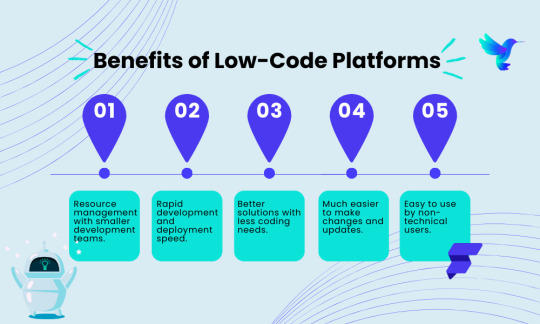
Rapid development and deployment speed.
Resource management with smaller development teams.
Better solutions with less coding needs
Easy to use by non-technical users, making it easier for them to contribute to the app development process.
Much easier to make changes and updates.
Thus with the ease and accessibility to even non-technical users, Low Code development is helping startups create professional applications on a budget. Some of the popular low-code platforms are Appian, Creatio, Outsystems, FlutterFlow, etc.
FlutterFlow gets a lead over others as it is taking low code development to new heights. Let’s now explore what makes FlutterFlow a perfect platform for your startup.
What is FlutterFlow?
FlutterFlow is built on Google’s Flutter framework, designed for developing cross-platform applications for Android, iOS, and the web. It offers a visual design interface, allowing users to plan app layouts effortlessly through simple drag-and-drop capability. FlutterFlow helps real-time collaboration, making it best for teams working together on a development project.
With an easy-to-use interface, no technical skills, and a strong framework to back it, FlutterFlow has been gaining popularity since it was conceived. Whether you are a startup or a small-scale business, if you want to create a mobile application that resonates with your audience, then, choose the FlutterFlow platform and let things flow.
Why FlutterFlow Is Perfect for Startups?
FlutterFlow is taking low code development to new heights by offering a visual development environment where users can build the solutions they want without compromising on app feature quality.
FlutterFlow basically incorporates and promotes best practices for software development. The platform streamlines complex IDE tasks into an intuitive UI, making developer interactions easier. To use the platform one needs basic training, thus even non-developers get into the basics of core app development concepts.
FlutterFlow entered the market with a vision to go from low code development to visual development. Here’s how the team is planning to achieve their goals:
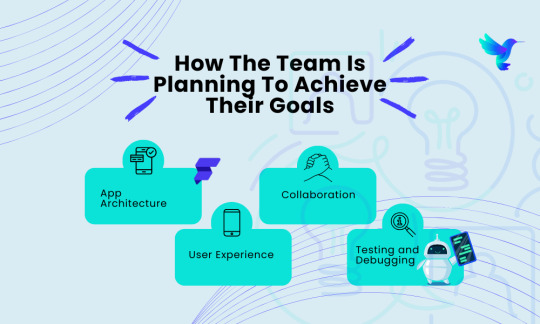
App Architecture: The codes generated using FlutterFlow meet the standards set by Flutter and Dart. They abide by the standard app market, thus helping users with a credible app development solution.
Testing and Debugging: The developers can simply test and debug the applications by running, testing, and resolving issues. This allows startups to enter the market with a flawless and highly rewarding application.
Collaboration: With modular development, smart version controls, and comprehensive access management, users can collaborate easily for better results.
User Experience: With an easy-to-explore interface, edit on clicks, ensure consistency, incorporate AI where possible, and users can switch between code and GUI.
FlutterFlow offers startups an environment where they can cross-operate, collaborate, and discuss their problems. The platform is conceived to make development easier, more convenient, and accessible for non-tech people also, who can easily make their contribution to the web now!
Some of the other advantages of the platform are:
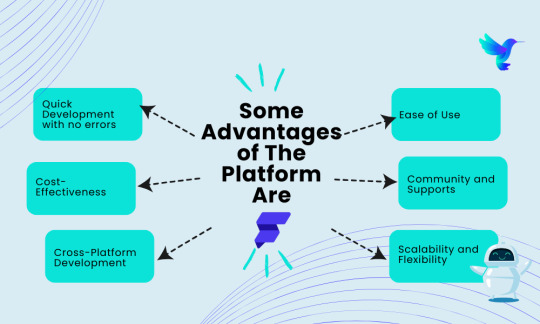
1. Quick Development With No Errors
The cheat code to making the best of your business is, to enter the market ASAP.
One of the most significant benefits of FlutterFlow is the speed at which the projects may develop. The platform’s visual interface and pre-built elements allow for speedy prototyping and development. Startups can fast-build minimum viable products (MVPs) to check thoughts in the marketplace without making a heavy investment in development sources.
Thus, you can create a product faster, take it to the market, and get feedback easily. We understand not every product works well on the first go, but with FlutterFlow you get the ease of making iterations and offering your audience a solution they’d appreciate.
2. Cost-Effectiveness
Most startups run on budget constraints. FlutterFlow helps reduce investing in large teams of seasoned developers. The platform’s drag-and-drop capability and pre-built templates lessen the quantity of custom code required, which translates to lower support and maintenance fees. A developer with lesser experience and understanding of the development languages can also, easily create an app here making it easier for you to invest your funds in other business verticals too.
3. Cross-Platform Development
FlutterFlow’s foundation lies at the Flutter framework which guarantees that applications are cross-platform by default. Thus by picking FlutterFlow startups can create and deploy applications to iOS, Android, and net platforms simultaneously. This cross-platform functionality is crucial for startups looking to maximize their target audience and digital presence without incurring the expenses and complexities of keeping separate codebases for specific platforms.
4. Ease Of Use
FlutterFlow is designed to be user-friendly, making it accessible to both skilled app developers and those with limited coding exposure. This democratization of app development means that non-technical founders and team members can contribute to the development procedure. FlutterFlow also gives tremendous documentation and tutorials, further decreasing the barrier to entry.
Because it is easy to use, the startup founders can make changes to the product as they want.
5. Scalability And Flexibility
Despite being a low-code platform, FlutterFlow gives massive flexibility. Users can add custom code to increase the functionality of their programs, making sure that they are now not confined with the aid of the platform’s built-in features. FlutterFlow additionally integrates seamlessly with backend services like Firebase and Supabase, bearing in mind robust and scalable backend solutions.
6. Community And Support
Being part of the Flutter ecosystem, FlutterFlow advantages from an active and supportive community. This network affords a wealth of assets, tutorials, and discussions that could assist startups conquer challenges and make the most of the platform. Additionally, FlutterFlow is continually evolving, with new capabilities and improvements being brought often based on user comments.
New users can always connect with the community for any assistance and customization thus creating a growth-oriented and learning ecosystem.
These are some of the most popular reasons why FlutterFlow is one of the most prominent low-code platforms for startups. So, if you are aiming to start your entrepreneurial journey and aren’t sure how to start without investing much in development, FlutterFlow is your trusted development partner.
Addressing Common Concerns of Using FlutterFlow
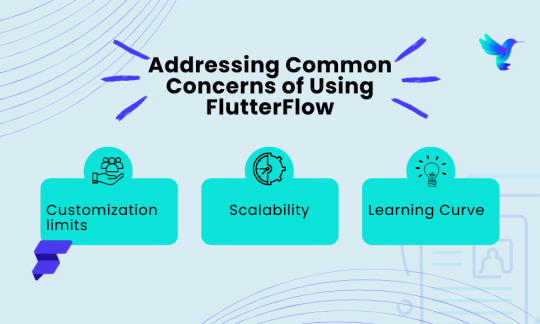
FlutterFlow may offer a great advantage for startups and businesses, but it does come with some limitations. Let’s explore the common concerns when working on the platform.
Customization Limits
The most common and often-faced concern with low-code platforms is the potential difficulty of customization. However, FlutterFlow mitigates this with the aid of custom code integration. This ensures that whilst you can enjoy the speed and efficiency of low-code development, you still have the flexibility to put into effect custom functions as wanted.
Scalability
Another concern is scalability. FlutterFlow is designed to handle significant user load and great data volumes through its integration with a powerful backend. Startups can hopefully scale their packages as their customer base expands, knowing that the platform is designed and developed to meet their business needs.
Startups with a limited user base can use the capabilities of FlutterFlow for future preparedness.
Learning Curve
While FlutterFlow is user-friendly, there can still be a strong learning curve, specifically for those new to app development. However, the considerable assets available, together with documentation, tutorials, and network help, assist mitigate this challenge.
Startups can always seek assistance from other development agencies experienced in FlutterFlow to boost learning and make sure first-class practices are followed. With little time and dedication, one can excel in their skills and implement them to build innovative products for the future.
Conclusion
FlutterFlow represents a tremendous advancement in the realm of low-code development systems, particularly for startups. Its combination of speed, value-effectiveness, ease of use, and flexibility makes it a super choice for early-stage businesses seeking to deliver their thoughts to the marketplace. By leveraging FlutterFlow, startups can reduce development time and fees, build cross-platform applications, and remain agile in a competitive landscape.
For startups and small-scale organizations trying to maximize their assets and boost their development process, FlutterFlow offers a compelling solution that bridges the gap between rapid prototyping and strong, scalable app development. As the platform continues to evolve and improve, it’s far poised to end up a good extra effective device for startups aiming to innovate and be triumphant in the virtual age.
#FlutterFlow#Custom App Development#FlutterFlow Startup businesses#Challenges for startups businesses#Low Code Development#graphical user interfaces#Benefits Of Low-Code Platforms#Google’s Flutter framework#cross-platform applications#Hire Flutter Developers#software development#advantage for startups and businesses
0 notes
Text
Looking for Cross App Development Company
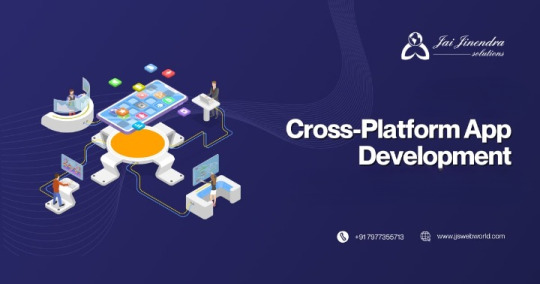
ur company specializes in cross-platform app development, ensuring seamless compatibility across multiple operating systems.We offer bespoke cross-app solutions tailored to your specific business needs, providing unique functionalities and features.
Native and Hybrid App Development: Explore the best of both worlds with our native and hybrid app development expertise, delivering high-performance apps with optimal user experiences.
Cross-App Integration: Seamlessly integrate your apps across different platforms, enhancing user engagement and streamlining business operations with our cross-app integration solutions.
Get more info: https://www.jjswebworld.com/service/mobile-app-development
#crossplatformappdevelopment#framework#flutter#reactnative#app#mobileappdevelopmentcompany#mobileapplicationdevelopment#development#reactnativeapp#NativeAppDevelopment#business
0 notes
Text
0 notes
Text
#difference between flutter and react-native#flutter and react-native difference#cross-platform app development company#right framework for cross-platform apps#top flutter app development company#best react native app development company#hire nearshore mobile app developers
0 notes
Text
#Flutter App Development Company in Saudi Arabia#best flutter app development company#Flutter App Development Company#android and ios app development#android and ios platforms#best app development services#flutter application development#Flutter app development#Flutter framework#create apps#top flutter developers#best sites to hire flutter developers
1 note
·
View note
Text
youtube
How to Lead Cross-platform App Development Framework with Flutter: An Ultimate Guide 2024
Unlock the power of cross-platform app development with Richestsoft Ultimate Guide for Flutter in 2024. Seamlessly navigate through the complexities of leading frameworks, as Richestsoft provides expert insights and strategies. Elevate your app development game with cutting-edge techniques, ensuring success across diverse platforms. Master Flutter with Richestsoft unparalleled expertise.
0 notes
Text
Exploring the Future: Mobile App Development Framework Trends in 2024
Introduction
The ever-evolving landscape of mobile app development is constantly shaped by technological advancements and user preferences. As we step into 2024, the mobile app development framework trends are set to redefine the way we create and experience mobile applications. In this comprehensive blog post, we'll explore the cutting-edge developments in the industry, highlighting the significance of hiring cross-platform app developers and the rising demand for React Native developers.
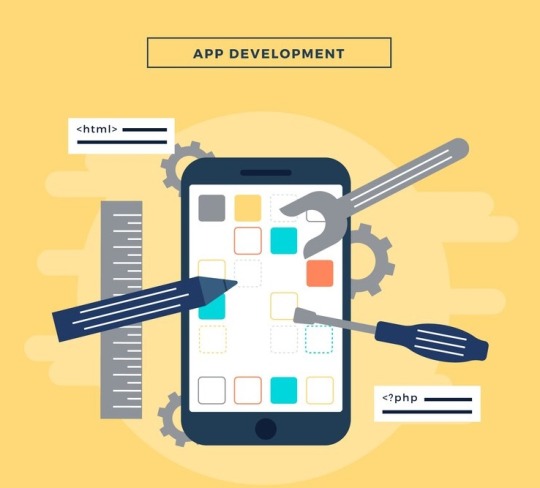
The Rise of Cross-Platform App Development
Cross-platform app development continues to gain momentum in 2024, offering a cost-effective and efficient solution for businesses targeting multiple platforms simultaneously. The ability to write code once and deploy it across various platforms, such as iOS and Android, makes cross-platform development an attractive choice for many businesses.
Why Hire a Cross-Platform App Developer?
Hiring a cross-platform app developer brings several advantages to the table. These developers specialize in frameworks like Flutter and Xamarin, allowing them to create applications with a single codebase. This not only accelerates the development process but also reduces costs associated with maintaining separate codebases for different platforms.
Flutter: Google's Darling Framework
Flutter, backed by tech giant Google, has emerged as a frontrunner in the cross-platform development arena. Its ability to deliver a native-like experience across various platforms has led to an increased adoption rate. Flutter's hot reload feature enhances developer productivity, enabling them to see real-time changes instantly.
Businesses looking to streamline their app development process and create visually appealing, high-performance applications should consider hiring cross-platform app developers proficient in Flutter.
Xamarin: The Microsoft Advantage
Microsoft's Xamarin continues to be a dominant force in cross-platform development. With a strong backing from a tech powerhouse like Microsoft, Xamarin allows developers to use C# for building applications that can run on iOS, Android, and Windows. This level of flexibility makes Xamarin a preferred choice for enterprises seeking a comprehensive solution.
Hire Cross-Platform App Developers for Seamless Integration
Cross-platform app developers play a crucial role in ensuring seamless integration of your app across various platforms. Their expertise in utilizing frameworks like Flutter and Xamarin guarantees a consistent user experience, regardless of the device or operating system.
React Native: The JavaScript Powerhouse
In the realm of native app development, React Native continues to be a popular choice. Developed by Facebook, React Native leverages the power of JavaScript to create high-performance, native-like mobile applications. The framework's modular and reusable components facilitate a more efficient development process.
Why Hire a React Native Developer?
Businesses seeking a native app development experience with the advantages of cross-platform development often turn to React Native. By hiring a React Native developer, you gain access to a pool of talent capable of building robust applications that run smoothly on both iOS and Android devices.
Frequently Asked Questions (FAQs) - Mobile App Development Framework Trends in 2024
Q1: What is the significance of cross-platform app development in 2024?
A1: Cross-platform app development allows developers to write code once and deploy it across multiple platforms, such as iOS and Android. This approach is cost-effective and efficient, making it an attractive choice for businesses aiming to reach a broader audience without doubling development efforts.
Q2: Why should I hire a cross-platform app developer?
A2: Hiring a cross-platform app developer brings numerous benefits, including accelerated development timelines and cost savings. These developers specialize in frameworks like Flutter and Xamarin, enabling them to create applications with a single codebase, reducing maintenance overhead and ensuring consistency across platforms.
Q3: What is Flutter, and why is it gaining popularity in 2024?
A3: Flutter is a cross-platform development framework backed by Google. Its popularity in 2024 is attributed to its ability to deliver a native-like experience across various platforms. The hot reload feature enhances developer productivity by allowing real-time changes, making it a preferred choice for businesses seeking visually appealing and high-performance applications.
Q4: How does Xamarin stand out in the cross-platform development landscape?
A4: Xamarin, supported by Microsoft, stands out due to its flexibility in using C# for building applications compatible with iOS, Android, and Windows. The framework is known for its seamless integration with the Microsoft ecosystem, making it an ideal choice for enterprises seeking a comprehensive cross-platform solution.
Q5: Why should businesses consider hiring React Native developers?
A5: React Native, developed by Facebook, combines the efficiency of JavaScript with native app development capabilities. Businesses should consider hiring React Native developers for creating high-performance applications that offer a native-like experience on both iOS and Android devices. The framework's modular and reusable components contribute to an efficient development process.
Q6: How do cross-platform app developers ensure seamless integration across various platforms?
A6: Cross-platform app developers leverage frameworks like Flutter and Xamarin to ensure seamless integration. Their expertise allows for the creation of applications with a consistent user experience across different devices and operating systems, eliminating compatibility issues.
Q7: Can React Native be used for both iOS and Android app development?
A7: Yes, React Native is designed to support both iOS and Android app development. This makes it an excellent choice for businesses looking to build cross-platform applications while maintaining a native look and feel.
Q8: What are the advantages of modular and reusable components in React Native?
A8: The modular and reusable components in React Native contribute to a more efficient development process. Developers can create building blocks that can be reused across different parts of the application, reducing redundancy and enhancing maintainability.
Q9: How can businesses stay ahead in the competitive mobile app development market in 2024?
A9: To stay ahead, businesses should consider embracing cross-platform development frameworks like Flutter and Xamarin or opt for React Native for a native app experience. Additionally, hiring skilled cross-platform app developers or React Native developers is crucial to turning innovative ideas into successful mobile applications.
Q10: What are the key possibilities for mobile app development in 2024?
A10: In 2024, the key possibilities for mobile app development include creating innovative and user-friendly applications using cutting-edge frameworks like Flutter, Xamarin, and React Native. Businesses can explore new avenues for reaching a wider audience and delivering optimal user satisfaction by harnessing the capabilities of these frameworks and the expertise of skilled developers.
#reactnative#flutter#cross platform#mobile app framework#ionic app development#mobile app development
0 notes
Text


In the rapidly evolving landscape of mobile app development, businesses are seeking innovative and efficient solutions to stay ahead of the curve. One technology that has gained significant traction is Flutter, a versatile and powerful framework for building cross-platform mobile applications. As the demand for seamless user experiences grows, businesses are turning to the expertise of a trusted mobile app development company in the USA to harness the full potential of Flutter app development services.
#android app development company in usa#mobile app development company in usa#flutter app development services#hybrid app development framework#best app development software#best graphic designer services#best application development company#app development services usa#web and mobile development company#iphone app development usa#ios development companies in usa#android app development company us#mern stack developer services#flutter app development at top
0 notes